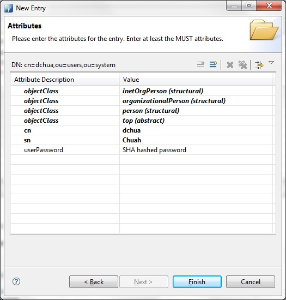Installation LDAP server on OpenDS and ApacheDS in JIRA (Windows Environment)
This page contains an example of how to install/configure LDAP server on OpenDS and ApacheDS based in Windows environment in JIRA.
Comparison between OpenDS and ApacheDS in terms of Specifications and Offered Features
| OpenDS | ApacheDS | |
|---|---|---|
| Licensing | Open Source and Free | Open Source and Free |
| Language Written | Java | Java |
| Supported Environment | Linux and UNIX distributions, Microsoft Windows, Mac OS X, | Linux and UNIX distributions, Microsoft Windows, Mac OS X, |
| Download Link | https://opends.java.net/public/downloads_index.html | http://directory.apache.org/apacheds/downloads.html |
| Installation Method |
|
|
| Java Platform | Java Runtime Environment 1.5 and above | Java Runtime Environment 1.6 and above |
| Offered Features |
| The Apache Directory Server is an embeddable LDAP server implemented in pure Java. It has several features that make it unique among LDAP servers. Some of these featurea are as follows:
|
| Unique Usage Point |
|
|
Basically both of these LDAP directory server environment it is quite similar in terms of specification and supported environment too as is widely available for almost all operating system since it is both running in Java based application. Best of all it is open source and free.
Installation
OpenDS
- Download OpenDS 2.2 Update 1 archive zip and extract it out to a particular location
Run setup.bat file and then basically follow either one of the tutorial below to setup your LDAP server
Video tutorial Document tutorial https://java.net/projects/opends/pages/2_4_OverviewOfTheQuickSetupTool
ApacheDS
- Download ApacheDS 2.0.0-M13 and Apache Directory Studio 2.0.0-M7 either 32-bit or 64-Bit
- Install ApacheDS first with the installation wizard then do the same for Apache Directory Studio (pretty straightforward)
- After that launch Apache Directory Studio, you can basically follow the instruction to create a LDAP server in here: http://directory.apache.org/studio/users-guide/ldap_browser/gettingstarted_create_connection.html
Setting it up with JIRA
Setup Environment:
| OpenDS | ApacheDS |
|---|---|
|
|
General Setup Guidelines
- Setup LDAP server in both OpenDS and ApacheDS (refer the installation instruction above)
- Configure the users and groups in both server
- Fresh install JIRA 5.2.11 connected with a fresh empty Postgres database
- Go to Administrator > Users > User Directories > Add Directory
- Choose Directory Type: LDAP and select Apache Directory Server 1.5.x for ApacheDS and OpenDS for OpenDS
- Fill up all other required field: Name, Directory Hostname, Port and Base DN
- Select Read Only as the LDAP Permissions
Make sure the attributes and object class you set in your LDAP server is correctly match the attributes that you bind in JIRA (under User and Group Schema Settings).
Example:
- The default bind user name attribute for OpenDS in JIRA(User Schema Settings) is uid so in your OpenDS LDAP server you have to set your username under user id attribute.
- The default bind user name attribute for ApacheDS in JIRA(User Schema Settings) is cn so in your ApacheDS LDAP server you have to set your username under common name attribute.
Differences in terms of User Interface and Configuration
| UI | OpenDS | ApacheDS | ||||||||||||
|---|---|---|---|---|---|---|---|---|---|---|---|---|---|---|
| Main | ||||||||||||||
| Create User |
|
| ||||||||||||
| Create Group |
|
|














